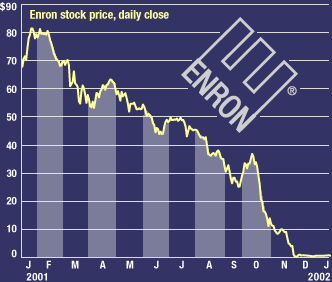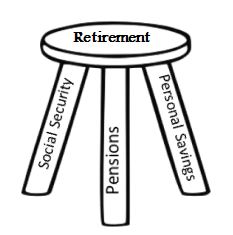After my last post, I thought I would do a follow-up post where I covered some of the risks of not being diversified in your investment account. I am sure you noticed the picture above this post. In 2001, Enron became synonymous with greed, corruption, scandal, and severe economic loss to their shareholders, employees, and overall stakeholders. Why would I bring up Enron as an example of not being properly diversified on this blog? I want to tell you a true story about a lady I met in a retirement planning workshop I was hosting many years ago.
I was conducting the retirement planning workshop for a company in Pensacola, FL. As I finished my presentation, a lady approached me with quite a sense of urgency. She boastfully told me that I, and all financial professionals, did not know what we were talking about. She told me how we were just full of lies and greed, and most of all we just wanted to steal other people’s money. Then she told me the real reason for her rant, she was not a psychic, had never met me before, but she made all of her assertions about myself and the financial planning profession based on four simple words- “I’m an Enron victim.” Now this was about two years after Enron finally crumbled into oblivion, but for her, the wounds and scars were still abundantly fresh.
I tried to listen with empathy to her story. She had lost all of her retirement savings (I would have guessed her age to be in her 50s). She was starting over financially, but she proudly proclaimed she would never invest one dime in a company’s retirement plan. I say I was trying to listen with empathy because one question kept running through my mind – where was the diversification in her account? You see, she violated one of the golden rules of investing – never have all you eggs in one basket. She lost all of her retirement savings, but the really sad part is, she could have easily prevented this loss. The financial planning industry and your humble blogger she was ranting to would have never encouraged her to put all of her money in one basket. This was a truly stupid investment plan and strategy because the potential loss was far greater than the potential reward.
When she told me she was an Enron victim, in my mind – certainly not out loud where she could hear me- I thought, there really were not very many Enron victims. Why would I say such a thing? She and thousands of others had their retirement savings completely wiped out by the fraud that ultimately caused the bankruptcy. They were just innocent victims, right? Well, they probably did not know the company was a virtual fairytale of commerce, but they also took an insane amount of risk in having just one, literally one, investment in their entire account.
Warren Buffet, possibly the most successful investor of all time, says two things move the financial markets: fear and greed. I am always amazed at how powerful these two emotions can become. These emotions can completely remove all reason and rationale from totally reasonable and rational people. This powerful emotion of greed played into this woman’s, and many other investors just like her, plan for saving for retirement, and it blinded them to one of the aforementioned golden rules of investing.
Let me illustrate my point like this: imagine we both work at Enron and it is March of 2001. We both make the same amount of money, we both save the same amount in our respective 401k accounts, and we both have been participating for roughly the same time period. There is one distinct difference in our accounts – the account balance. You see, I have all my money in Enron’s common stock, and it has done remarkably well. So well in fact, that my account value is more than three times greater than your account value. You have the S&P 500 Index fund as your investment (by the way, at the time, I believe Enron ranked number 6 on the S&P 500). You don’t have just one company that your money is invested in like I do, no, you have 500 different companies that your money is spread out among. Hopefully before I go any further you already see the benefit in having 500 different companies than having just one.
Again, it is March of 2001, Enron’s common stock is roughly $70 per share, and I have over $1,000,000 in my 401k. You on the other hand, have a mere $300,000 in your 401k. If you recall, we have been doing the same thing in our retirement account with one glaring exception, the investment. I come to you and let you know how stupid you are, how much money you are giving up, how much more my account is, and how much better of a retirement I am going to enjoy rather than the one you will have to endure. By the way, this is exactly what was going on in the company based on the first-hand accounts of actual Enron employees. Fast forward with me now in our hypothetical discussion to October of 2001. Oh my, how quickly things have changed! It is just seven months later in the calendar, not years and years, but now the amount we would have in our respective 401k’s could not be any different.
By October 2001, Enron’s common stock had collapsed to less than $1 per share from approximately $85 per share just seven months earlier. My million dollar 401k, would now be worth a couple thousand dollars. The money has essentially vanished into thin air. Your account, on the other hand, is still worth roughly $300,000 – who was the smart one now? How can this be? Very simple. This is the risk of not being properly diversified in your investment portfolio. I had one thing – it went bankrupt and I was left with essentially nothing. You had 500 different companies, one of which went bankrupt. The difference was you still had 499 that were still operating.
This is why I say there were very few real Enron victims. Were they complaining in March of 2001 when the stock was $85 per share, not likely. You cannot chase investment returns (investing in what is the current best performer) when you are saving for retirement. You must develop a well conceived plan that includes a definitive retirement savings goal amount, realistic investment returns (20% or more a year is not realistic long-term whatsoever), and adequate contribution amounts to help fund your account. Then you must stick to that plan and be extremely cautious about drifting from that plan. Yes, you will have to make adjustments to the plan as you go throughout your working career, but that is normal and should be expected. You must stick to your plan (and revised plan) and not worry about the high-flying returns that this stock or this particular sector is giving; because as any Enron “victim” can tell you, the stock or sector can take those gains back at any point. Saving for retirement is not get rich quick, but it is get rich slow!








